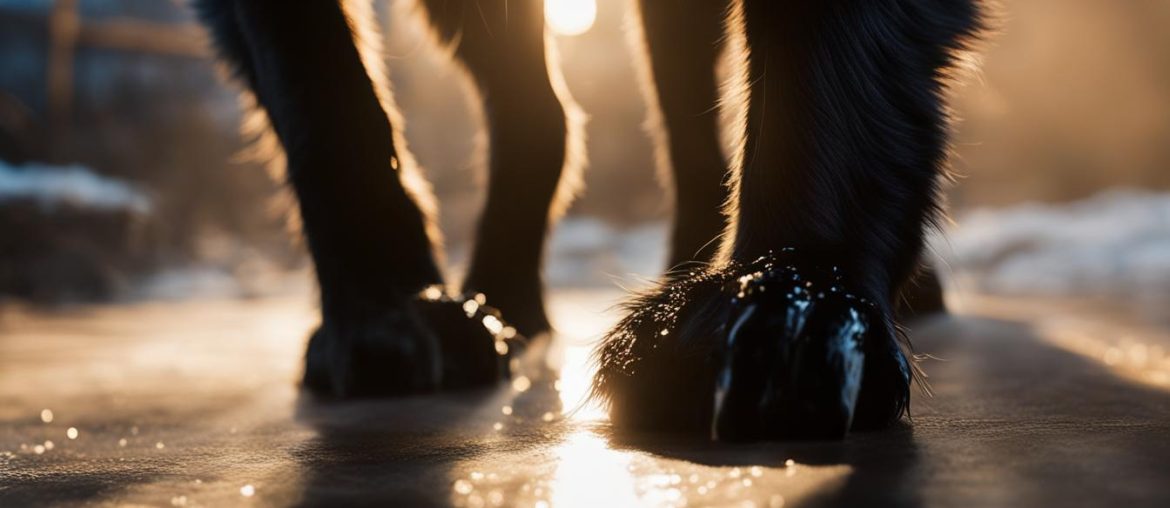Teaching your dog to cover his nose is a versatile behavior that can be useful in various situations. It can be a fun trick to entertain guests or a way to redirect your dog’s attention. Before you start training, gather high-value treats and a treat bag. Take it slow and lay down foundational steps for your dog to learn. There are different methods to choose from, such as nose targeting, paw targeting, and rear-foot targeting.
Key Takeaways:
- Teaching your dog advanced tricks strengthens the bond between you and your dog and enhances their overall obedience.
- Mastering advanced tricks improves your dog’s mental stimulation and builds their confidence.
- High-value treats and a treat bag are essential training supplies to keep your dog’s attention and reward their progress.
- Methods like nose targeting, paw targeting, and rear-foot targeting can be used to teach your dog to put their paw on their nose.
- Building a strong foundation and keeping training fun and positive are important for successful training sessions.
The Importance of Teaching Advanced Tricks
Teaching advanced tricks, like covering the nose, goes beyond basic obedience. It strengthens the bond between you and your dog and enhances their overall obedience. Mastering advanced tricks improves your dog’s mental stimulation and builds their confidence. These behaviors can also be used as distractions or redirections in various situations.
“Training advanced tricks is not just about impressing others; it’s about deepening the connection with your dog and expanding their skill set,” says dog trainer and behaviorist Jane Smith. “When you teach your dog to cover their nose, you’re challenging their cognitive abilities and reinforcing your role as their trusted leader.”
Advanced tricks involve more complex movements and require a higher level of focus and control from your dog. By teaching these advanced behaviors, you provide mental stimulation and challenge their problem-solving skills, further improving their overall behavior and obedience. It’s a rewarding journey that strengthens the bond between you and your furry companion.
Enhancing Bonding and Building Trust
One of the key benefits of teaching advanced tricks is the deepening bond and trust that develops between you and your dog. The training process requires clear communication, patience, and positive reinforcement, all of which contribute to a sense of teamwork and mutual understanding. As you work together towards a common goal, you’ll establish a stronger connection and create a positive environment for learning.
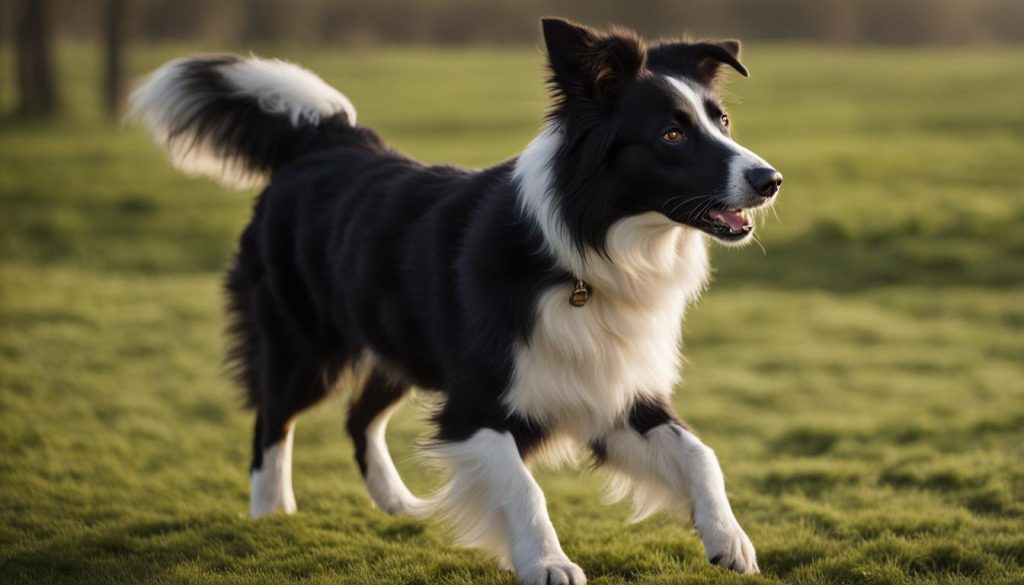
Expanding Your Dog’s Repertoire
Teaching advanced tricks opens up a world of possibilities for your dog’s training repertoire. Once they’ve mastered covering their nose, you can continue to challenge them with other complex behaviors, such as balancing objects on their nose or retrieving specific items by scent. These advanced tricks can serve as a great foundation for dog sports, including agility, obedience trials, and even dog dancing. The possibilities are endless, and the journey of advanced training is filled with fun and excitement.
| Benefits of Teaching Advanced Tricks | Bonding and Trust | Enhanced Mental Stimulation | Expanding Repertoire |
|---|---|---|---|
| Mutual understanding and teamwork | Challenges problem-solving skills | Opens doors to dog sports | |
| Deepens the bond between you and your dog | Builds confidence and focus | Provides mental stimulation and exercise | |
| Strengthens obedience and control | Creates a positive learning environment | Fosters a fun and rewarding training experience |
Supplies for Training Your Dog
To effectively train your dog to cover their nose, you should have the right supplies on hand. Here are some essential items you will need:
- High-value treats: These are treats that your dog finds particularly enticing and motivating. They should be small, soft, and easily consumable so that your dog can quickly enjoy their reward.
- Treat bag: A treat bag is a convenient accessory that allows you to have quick and easy access to treats during training sessions. It keeps your hands free and ensures that the treats are readily available.
- Training accessories: Depending on the training method you choose, you may need additional accessories such as target objects, platforms, or props to facilitate the training process. These accessories help create clear cues and guide your dog’s behaviors.
Having these supplies ready will ensure that your training sessions are smooth, efficient, and enjoyable for both you and your dog. Now let’s dive into the different methods you can use to teach your dog to cover their nose.
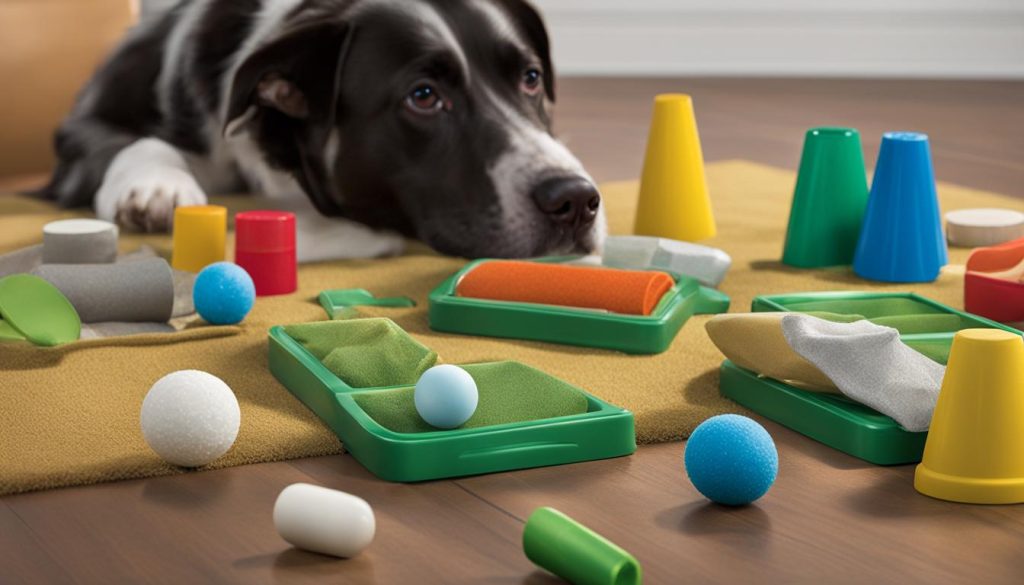
Nose Targeting Method
This method involves teaching your dog to touch an object with their nose. It is a great way to train your dog to cover their nose on command. To start, you can use your open palm as the target object. Hold your hand close to your dog’s face, and when they show interest or touch your hand with their nose, reward them with a treat and praise. Repeat this exercise and gradually increase the difficulty by asking your dog to target from different positions and with distractions. Consistent training will help your dog master the behavior.
Paw Targeting Method
Another method you can use is paw targeting, where you teach your dog to put their front paws onto an object. This method is useful if your dog is already familiar with targeting behaviors. You can start by using a low platform or a designated target object. Encourage your dog to touch the target with their paw by using a treat as a lure. Gradually raise the treat, so your dog’s front feet go up onto the platform. Repeat this process until your dog consistently puts their paws on the target object. Introduce a verbal cue and practice in different environments to solidify the behavior.
Rear-Foot Targeting Method
The rear-foot targeting method is an advanced technique that teaches your dog to touch an object with their rear feet. It is best to start with a low, solid platform and lure your dog to walk forward and up onto it, so their back feet are on the platform. Gradually fade out the lure and introduce a verbal cue. With consistent practice, your dog will learn to target objects with their rear feet on command. Try to always reward your dog’s progress and use positive reinforcement techniques throughout the training process.
Method 1: Nose Targeting
Nose targeting is an effective method for teaching dogs to touch their nose to an object. This training technique uses positive reinforcement to encourage the desired behavior. By following a step-by-step approach, you can successfully train your dog to cover their nose on command.
Step 1: Introducing the Target
Start by choosing a target object, such as your hand or a small disc. Hold the target close to your dog’s face and wait for them to show interest. When your dog touches the target with their nose, immediately reward them with a treat and praise. Repeat this process several times to establish a connection between the target and the reward.
Step 2: Shaping the Behavior
Gradually increase the difficulty by moving the target further from your dog’s face. Encourage your dog to follow the target with their nose and reward them each time they touch it. You can also introduce a verbal cue, such as “touch” or “cover,” to associate the behavior with a command.
Step 3: Adding Distractions
Once your dog consistently touches the target with their nose, introduce distractions to test their focus and obedience. Start by practicing in a quiet environment and gradually introduce mild distractions, such as noises or toys. Reward your dog for successfully covering their nose despite the distractions.
Step 4: Generalizing the Behavior
Practice nose targeting in different locations and with various objects to ensure your dog understands the command in different contexts. This will help generalize the behavior and make it more reliable in real-life situations. Reinforce the behavior with treats and praise each time your dog covers their nose on command.

Table: Training Steps for Nose Targeting
| Step | Description |
|---|---|
| Step 1 | Introduce the target object and reward your dog for touching it with their nose. |
| Step 2 | Gradually increase the distance between your dog and the target, shaping the behavior. |
| Step 3 | Add distractions to test your dog’s focus and obedience while targeting their nose. |
| Step 4 | Generalize the behavior by practicing in different locations and with various objects. |
Training your dog to cover their nose through nose targeting is a rewarding process that deepens the bond between you and your furry companion. Try to be patient, use positive reinforcement, and celebrate each small success along the way.
Method 2: Paw Targeting
To teach your dog to touch their paw to an object, you can use the method of paw targeting. This technique involves marking and rewarding your dog for engaging with a platform or surface with their front paws. By gradually raising the treat, you can encourage your dog to put more weight on their front feet, eventually lifting their paws onto the target object.
Start by introducing your dog to the platform. Place it on the ground and use a treat to lure your dog towards it. When your dog places their front paws on the platform, mark the behavior with a clicker or a verbal cue, such as “good job” or “yes,” and immediately reward them with a treat.
Repeat this process several times, gradually raising the treat to encourage your dog to lift their paws higher. Try to be patient and reward your dog for any progress they make. Practice in different environments to generalize the behavior, and eventually introduce a verbal cue, such as “paws up” or “touch,” to signal the behavior.
Using positive reinforcement, such as treats and praise, along with clicker training can be highly effective in teaching your dog to touch their paw to an object. This method encourages your dog to actively participate in the training process and reinforces their understanding of the desired behavior.
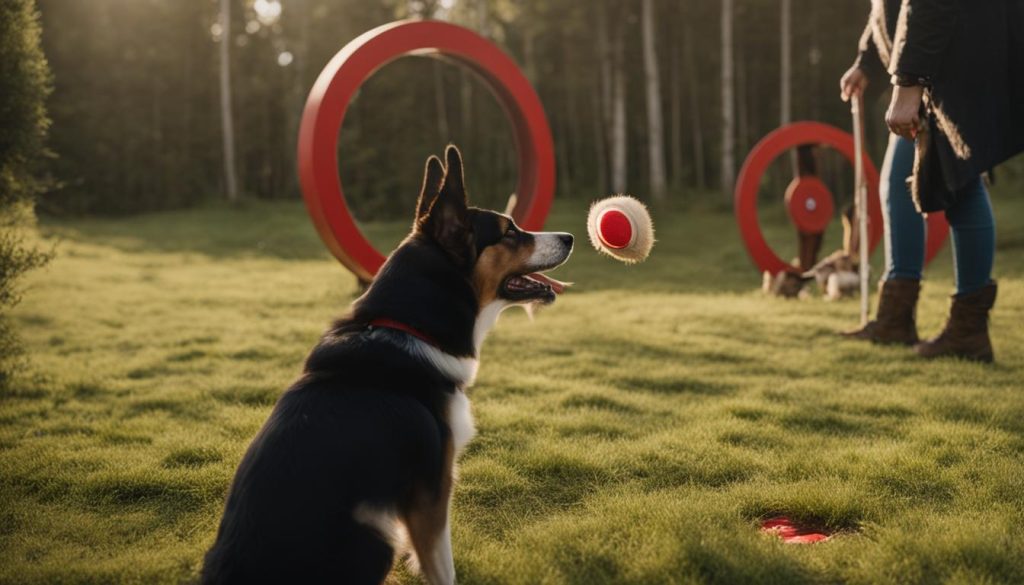
Benefits of Paw Targeting
Paw targeting not only teaches your dog a fun and impressive trick but also provides mental stimulation and physical exercise. It helps improve your dog’s coordination, body awareness, and focus. Additionally, paw targeting can be a useful skill for other advanced tricks and activities, such as teaching your dog to shake hands or participate in dog sports like agility or obedience trials.
Method 3: Rear-Foot Targeting
Another method for teaching your dog to cover their nose is through rear-foot targeting. This is an advanced skill that involves teaching your dog to touch an object with their rear feet. To start, you will need a low, solid platform that your dog can easily step onto.
Begin by luring your dog forward towards the platform with a treat. As they step onto the platform with their front feet, reward them for their engagement. Gradually fade out the lure and introduce a verbal cue, such as “rear foot” or “back feet.” With consistent practice, your dog will learn to target the object with their rear feet.
This exercise is a challenging one that requires balance and coordination from your dog. Be patient and offer plenty of rewards and praise as they progress. As they become more comfortable with rear-foot targeting, you can introduce different objects or surfaces for them to target. This will help generalize the behavior and ensure that your dog can perform rear-foot targeting in various environments.

Tips for Rear-Foot Targeting:
- Start with a low, stable platform for your dog to step onto.
- Use a treat to lure your dog forward and onto the platform with their front feet.
- Gradually fade out the lure and introduce a verbal cue for rear-foot targeting.
- Practice in different environments to generalize the behavior.
Rear-foot targeting is an advanced trick that can impress your friends and showcase your dog’s skills. It’s a fun and challenging exercise that provides mental stimulation for your dog. Try to be patient, use positive reinforcement, and celebrate your dog’s progress along the way.
Building a Strong Foundation
When it comes to training your dog to cover their nose, building a strong foundation is crucial. Foundational training forms the building blocks of your dog’s obedience and sets the stage for their success in learning advanced tricks. By taking a step-by-step approach, you can ensure that your dog understands each concept before moving on to the next.
Start by teaching your dog basic obedience commands such as sit, stay, and come. These commands establish a language of communication between you and your dog, making it easier to introduce more complex behaviors later on. Use positive reinforcement techniques, such as treats and praise, to reward your dog for following commands correctly.
Once your dog has a solid understanding of basic obedience, you can begin to introduce more advanced training exercises. Break down each new behavior into smaller steps and gradually increase the difficulty as your dog progresses. Try to be patient and consistent throughout the training process. Short, focused training sessions are more effective than long, drawn-out sessions that can lead to boredom or frustration.
| Building a Strong Foundation | Key Points |
|---|---|
| Start with basic obedience commands | – Sit, stay, come |
| Use positive reinforcement techniques | – Treats, praise |
| Break down each behavior into smaller steps | – Gradually increase difficulty |
| Be patient and consistent | – Short, focused training sessions |
By building a strong foundation of obedience and gradually introducing more advanced behaviors, you can ensure that your dog is prepared to learn and master the trick of covering their nose. Try to keep the training sessions fun and positive, and celebrate your dog’s accomplishments along the way.
Summary:
- Start with basic obedience commands like sit, stay, and come.
- Use positive reinforcement techniques such as treats and praise.
- Break down each behavior into smaller steps and gradually increase difficulty.
- Be patient and consistent with short, focused training sessions.
Keeping Training Fun and Positive
When it comes to training your dog, I would advise that you keep the sessions fun and positive. Positive reinforcement training is a highly effective method that focuses on rewarding desired behaviors rather than punishing unwanted ones. By using rewards such as treats, praise, and play as motivators, you can create a positive association with the training process for your dog.
Reward-based training not only strengthens the bond between you and your dog but also makes learning enjoyable for your furry friend. It taps into their natural instincts to seek rewards and encourages them to actively participate in training sessions. This approach promotes a positive learning environment and helps your dog to retain information better.
“Positive reinforcement is one of the most powerful tools in dog training. By rewarding your dog for their efforts and successes, you’re effectively communicating what behaviors you want to see more of. This method builds trust, confidence, and a willingness to learn, making training sessions enjoyable for both you and your dog.”
Incorporating fun activities and games during training sessions can also help keep your dog engaged and motivated. For example, you can play interactive games like hide-and-seek or teach them tricks like “spin” or “roll over.” These activities break the monotony of training exercises and inject an element of fun, making the experience enjoyable for your dog.
Try to keep training sessions short, around 5 to 10 minutes. Dogs have short attention spans, so keep them focused and interested. By keeping the sessions brief and ending on a positive note, you can maintain your dog’s enthusiasm and ensure that they look forward to future training sessions.

Table: Benefits of Fun and Positive Training
| Benefits | Explanation |
|---|---|
| Stronger bond | Fun and positive training activities help strengthen the bond between you and your dog, creating a deeper connection. |
| Increased motivation | When training is enjoyable, your dog will be more motivated to participate and learn new behaviors. |
| Improved learning retention | Dogs are more likely to remember and retain information when it is associated with positive experiences. |
| Enhanced focus and engagement | Fun training activities keep your dog engaged and focused on the task at hand, reducing distractions. |
Training Tips and Tricks
When it comes to training your dog to cover their nose, there are a few tips and tricks that can help make the process smoother and more successful. Here are some strategies and accessories that you can incorporate into your training sessions:
- Clicker Training: Consider using clicker training as a method to mark and reinforce your dog’s correct behaviors. The click sound provides a clear signal to your dog that they’ve done something right, making it easier for them to understand what you’re asking of them.
- Training Accessories: Utilize training accessories such as treat bags and target sticks to aid in your training sessions. A treat bag allows you to easily access rewards and keep your hands free, while a target stick can help guide your dog’s movements and encourage them to touch their nose or paw to specific objects.
- Training Strategies: Be patient and consistent in your training approach. Break down the behavior into small, manageable steps and gradually increase the difficulty as your dog progresses. Celebrate small successes along the way and provide plenty of positive reinforcement to keep your dog motivated.
“Training a dog is a journey that requires time, dedication, and understanding. By employing effective training tips and strategies, you can establish a strong bond with your dog and achieve impressive results.”
To put it simply, every dog is unique, so find the training methods that work best for your canine companion. Stay positive, be patient, and most importantly, have fun during your training sessions. With time and consistency, your dog will learn to cover their nose and impress everyone with their advanced trick!
| Training Tips and Tricks | Description |
|---|---|
| Clicker Training | Use a clicker to mark and reinforce correct behaviors. |
| Training Accessories | Utilize treat bags and target sticks for convenience and guidance during training. |
| Training Strategies | Employ patience, consistency, and positive reinforcement in your training approach. |
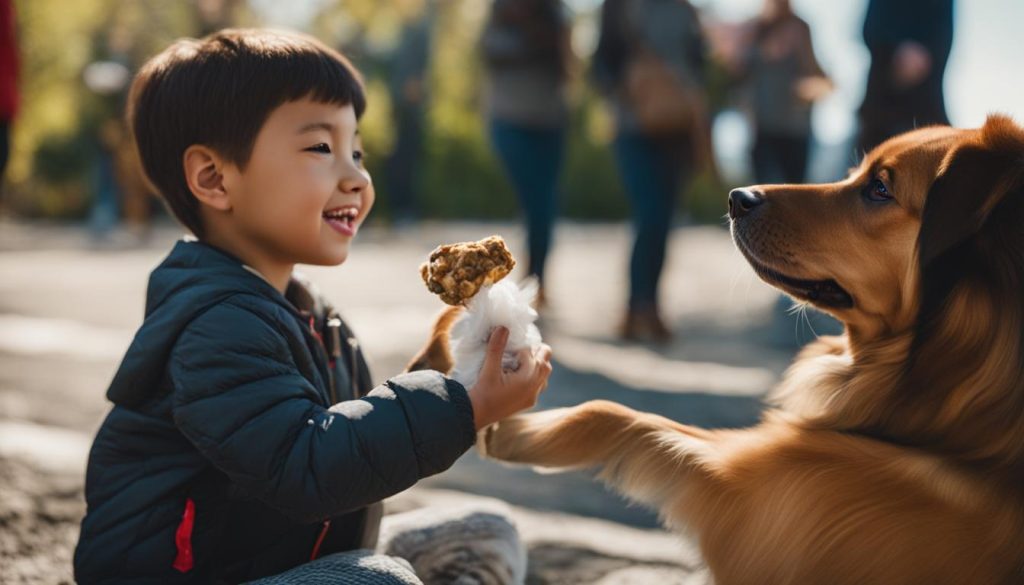
Additional Training Tips
Here are a few more training tips that can enhance your success in teaching your dog to cover their nose:
- Short and Frequent Sessions: Keep training sessions short, around 5 to 10 minutes, to maintain your dog’s focus and prevent them from becoming bored or tired.
- Consistency: Consistency is key in dog training. Use the same verbal cues and hand signals consistently so that your dog can easily understand and respond to your commands.
- Positive Reinforcement: Reward your dog with praise, treats, and affection when they successfully cover their nose. Avoid punishment or negative reinforcement as it can create confusion and hinder the learning process.
By implementing these training tips and strategies, you’ll be well on your way to teaching your dog this impressive advanced trick. Keep up the dedication and enjoy the journey of training your furry friend!
Taking Advanced Training Further
Now that your dog has mastered the trick of covering their nose, it’s time to take their advanced training to the next level. By expanding their training repertoire, you can provide even more mental stimulation and physical exercise for your furry friend. Consider incorporating other advanced tricks and behaviors into their training routine.
One option is to explore more complex targeting exercises. This could involve teaching your dog to touch specific objects with their nose, paw, or even their rear feet. By introducing new targets and challenges, you can continue to strengthen their obedience and focus.
Additionally, you may want to consider getting involved in dog sports. Activities like agility or obedience trials can be both fun and challenging for both you and your dog. These sports provide a structured environment for your dog to showcase their skills and abilities, while also promoting physical fitness and mental agility.
To ensure a successful transition to more advanced training, maintain a positive and rewarding approach. Continue using positive reinforcement techniques and plenty of treats to motivate and reward your dog’s progress. Try to keep training sessions short and engaging, allowing your dog to stay focused and excited about their training.

| Benefits of Taking Advanced Training Further | Ways to Expand Training Repertoire |
|---|---|
| 1. Increased mental stimulation for your dog. | 1. Introduce new targets for nose, paw, or rear-foot targeting. |
| 2. Enhanced physical exercise and fitness. | 2. Participate in dog sports like agility or obedience trials. |
| 3. Strengthened bond between you and your dog. | 3. Teach new advanced tricks and behaviors. |
Quote:
“Advanced training not only challenges your dog’s skills, but it also deepens the connection between you and your furry companion. Embrace the opportunity to expand their training repertoire and watch them thrive.” – Professional Dog Trainer
Final Thoughts
To sum it up, teaching tricks to dogs, such as the advanced skill of covering their nose, offers numerous benefits. Not only does it strengthen the bond between you and your dog, but it also enhances their overall obedience and mental stimulation. Through positive reinforcement training techniques and step-by-step methods like nose targeting, paw targeting, and rear-foot targeting, you can successfully teach your dog this versatile behavior.
By building a strong foundation and keeping training sessions fun and positive, you can ensure a successful learning experience for both you and your dog. Try to celebrate small successes and gradually increase the difficulty as your dog progresses. Additionally, consider exploring other advanced tricks and behaviors to expand your training repertoire and provide further mental stimulation for your dog.
Overall, dog training is a rewarding journey that offers countless opportunities for growth and enjoyment. By incorporating advanced tricks like covering the nose, you can unlock your dog’s full potential and create a deeper connection. So embrace the process, celebrate your dog’s accomplishments, and enjoy the journey of advanced dog training!
FAQ
How long should training sessions be?
Training sessions should be short, around 5 to 10 minutes, to maintain your dog’s interest and motivation.
What supplies do I need for training my dog?
You will need high-value treats, a treat bag for easy access, and training accessories for positive reinforcement.
What is nose targeting?
Nose targeting is a method where you teach your dog to touch an object with their nose.
How do I teach my dog paw targeting?
Paw targeting involves teaching your dog to put their front paws onto an object.
How can I teach my dog rear-foot targeting?
Rear-foot targeting teaches your dog to touch an object with their rear feet.
How do I build a strong foundation for training?
Take it slow and ensure your dog has mastered each step before moving on to the next.
How can I keep training fun and positive?
Use plenty of treats and rewards to reinforce your dog’s progress and success, and keep training sessions short and focused.
What are some training tips and tricks?
Consider using clicker training and a treat bag for convenience, and celebrate small successes along the way.
How can I take advanced training further?
Once your dog has mastered covering their nose, you can explore other advanced tricks and behaviors, such as those used in dog sports.


